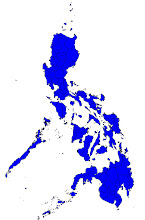by Bernadette E. Tamayo (Journal Online)
http://www.journal.com.ph/index.php/top-stories/4120-review-disaster-program--villar.html LA Trinindad, Benguet — After the devastating 8.8 magnitude that hit Chile which triggered worldwide tsunami warnings, presidential aspirant Sen. Manuel Villar, Jr. appealed to the government to review its disaster management program.
The Nacionalista Party standard bearer noted that the country, just like Chile, also lies in the “earthquake belt.” Villar said the government has to be ready for any eventuality since the tragedy that hit the Latin American nation resulted in a worldwide tsunami alert which included the Philippines.
“Medyo mag-isip-isip tayo. Hindi tayo p’wede magpabaya dito at siguruduhin natin na pag nagkaroon tayo ng ganito ay handa tumugon ang ating national government sa anumang kalamidad,” Villar said in a briefing before visiting the vegetable trading post here.
He added: “Dapat convinced na tayo rito na itong Pilipinas nasa earthquake belt din ito at itong nangyari sa Chile posibleng mangyari dito sa ating bansa. Dapat ang ating national government ay may kakayahan na umasiste sa sinumang local government saan mang lugar na magkakaroon ng ganitong kalamidad.”
Sen. Edgardo Angara said the massive earthquake which shook Chile not only caused extensive physical damage but also sent warning signals all around the countries in the Pacific ring of Fire, including the Philippines.
“Our tsunami warning reached level 2, meaning that people living along coastal areas should move higher inland,” said Angara.
He added: “This is another warning for us. If Ondoy and Pepeng were not enough, we ought to get our act together and be prepared for the next time that mother nature decides to come down hard and pummel the Philippines again.”
A joint study by Columbia University and the World Bank entitled “Natural Disaster Hotspots: A Global Risk Analysis,” which identifies countries which are at high risk for six major natural hazards: earthquakes, volcanoes, landslides, floods, drought, and cyclones, has the Philippines pegged as one of the riskiest countries in the world.
“It is reasonable to assume that it is only a matter of time before we are stricken by another great catastrophe. The science is there telling us that the risk is real. Our experiences in the past couple of decades alone have shown us the fact that our country is prone to disasters, and as such I believe our efforts to create the Disaster Science Center should be fast-tracked,” Angara said.
The Disaster Science Center is a project of the Congressional Commission on Science, Technology, and Engineering (COMSTE), which is primed to become a regional training center for disaster preparedness.
“This will not be the run of the mill, classroom-lecture type of learning, but an innovative center that harnesses the experiences of nations used to dealing with disasters, like Japan, that will help teach their hard earned lessons to our LGU’s and those of other countries as well,” said Angara, who chairs COMSTE.
“Taiwan, another country that is listed as high risk for natural calamities, is already on board with us, and by sharing our experiences and more importantly, the information, science and technology, we can make our country better prepared to face the worst natural disasters and minimize damage and the loss of life,” he said




No comments:
Post a Comment